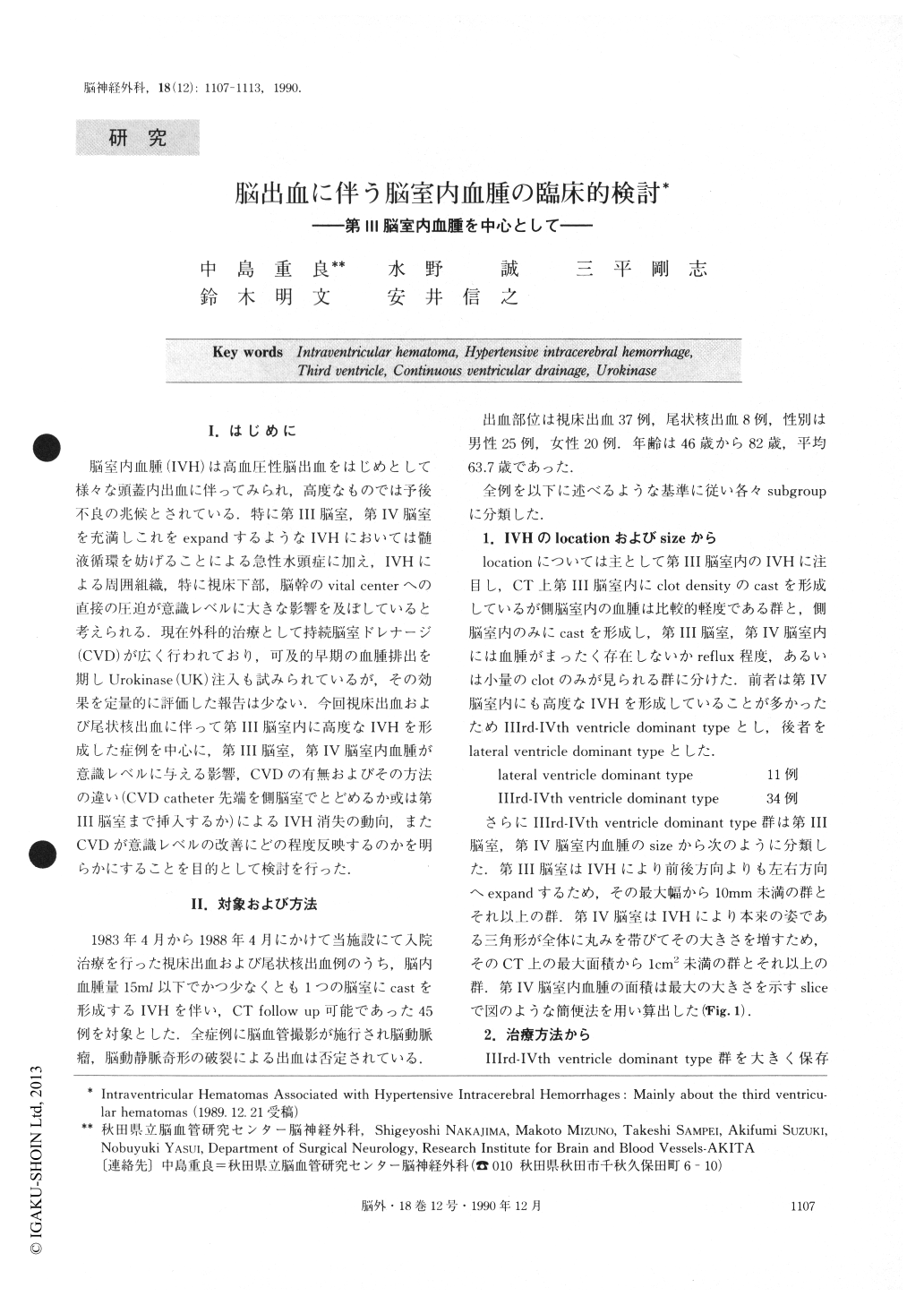Japanese
English
- 有料閲覧
- Abstract 文献概要
- 1ページ目 Look Inside
I.はじめに
脳室内血腫(IVH)は高血圧性脳出血をはじめとして様々な頭蓋内出血に伴ってみられ,高度なものでは予後不良の兆候とされている.特に第III脳室,第IV脳室を充満しこれをexpandするようなIVHにおいては髄液循環を妨げることによる急性水頭症に加え,IVHによる周囲組織,特に視床下部,脳幹のvital centerへの直接の圧迫が意識レベルに大きな影響を及ぼしていると考えられる.現在外科的治療として持続脳室ドレナージ(CVD)が広く行われており,可及的早期の血腫排出を期しUrokinase(UK)注入も試みられているが,その効果を定量的に評価した報告は少ない.今回視床出血および尾状核出血に伴って第III脳室内に高度なIVHを形成した症例を中心に,第III脳室,第IV脳室内血腫が意識レベルに与える影響,CVDの有無およびその方法の違い(CVD catheter先端を側脳室でとどめるか或は第III脳室まで挿入するか)によるIVH消失の動向,またCVDが意識レベルの改善にどの程度反映するのかを明らかにすることを目的として検討を行った.
Intraventricular hematoma (IVH) is often associated with many kinds of intracranial hemorrhage ; for exam-ple, hypertensive intracerebral hemorrhage, subarach-noid hemorrhage, and so on. In this paper we discuss the clinical significance of IVH in the third ventricle, as well as the effects of surgical treatment. Forty-five patients were treated in our hospital be-cause of massive IVH associated with small or mode-rate-size (hematoma volume ≦15ml) thalamic or caudate-head hemorrhage between April, 1983 and April, 1988. All cases had an intraventricular cast in at least one ventricle.
The patients were divided into two subgroups (depending on the site of the dominant IVH) : the third-fourth ventricle dominant type-IVH group, and the lateral ventricle dominant type-IVH group. The for-mer was further divided into two subgroups based on the thickness of the IVH in the third ventricle (its thickness being ≧ 1 cm and < 1cm) , and the area of IVH in the fourth ventricle (its area being ≧ 1cm2 and < 1cm2) as determined by CT scan monitoring. All cases were also divided according to continuous ven-tricular drainage (CVD), position of the catheter tip (in either the third ventricle or the lateral ventricle) , andthe intraventricular administration of urokinase (UK) . For each group we checked the consciousness grade us-ing the Glasgow Coma Scale (GCS) on day 0 and on day 7, as well as the interval between day 0 and the day on which the IVH in the third ventricle dis-appeared on the CT scan.
The GCS score of large third-fourth ventricle domi-nant-type IVH group on day 0 (IVH's in the third venticle being ≧ 1 cm, in the fourth ventricle being 1cm2) was lower than that of both the small third-fourth ventricle dominant-type IVH group (IVH's in the third ventricle being < 1cm, in the fourth ventricle being < 1cm2) and the lateral ventricle dominant-type IVH group. The time intervals (between day 0 and the day on which the IVH in the third ventricle dis-appeared) in the group that was treated by the third ventricular CVD with intraventricular administration of UK, were shorter than those of the other groups. In the other groups, the intervals tended to be proportionate to the thickness. The GCS score of the CVD group on day 7 was an average of 3.5 points higher than it was on day 0. This value was higher than that of the non-surgical group.
IVH, especially in the third or fourth ventricle, is thought to cause not only severe obstructive hy-drocephalus, but also serious damage to the vital cen-ters in the brain. Because IVH in this area of the brain is so critical, it should be removed as quickly as pos-sible by the insertion of a CVD catheter into the third ventricle, and by the intraventricular administration of UK through that catheter.

Copyright © 1990, Igaku-Shoin Ltd. All rights reserved.


